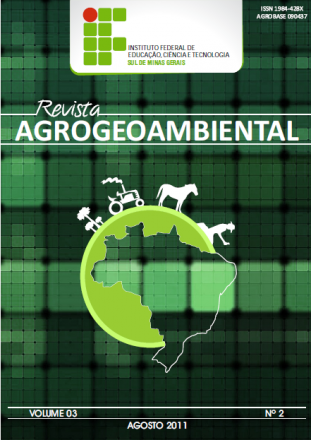Physical-hydric quality of a Regosol under integrated and conventional crop production systems
Revista Agrogeoambiental
Physical-hydric quality of a Regosol under integrated and conventional crop production systems
Autor Correspondente: N. G. de . Figueiredo Neto | [email protected]
Palavras-chave: available water; conservationist agriculture; semiarid; sandy soil.
Resumos Cadastrados
Resumo Português:
Os solos arenosos ganharam maior atenção devido à expansão das novas fronteiras agrícolas no Brasil e no mundo, contudo, são sensíveis às mudanças de uso do solo. Objetivou-se avaliar a qualidade físico-hídrica de um Neossolo Regolítico sob sistemas de produção integrados e convencionais nas condições climáticas do domínio do semiárido da Paraíba. O estudo foi realizado no município de Lagoa Seca/PB (7°10’15”S, 53°51’43”W, 640 m de altitude), em um Neossolo Regolítico de classificação textural franco arenosa. O experimento foi instalado em delineamento inteiramente casualizado, com cinco tratamentos e cinco repetições. Os tratamentos foram compostos por: 1) mombaça (Panicum maximum Jacq.) + milho (Zea mays L.) (M+M); 2) Urochloa decumbens (Stapf) R.D. Webster + milho (U+M); 3) mata secundária (MS); 4) área de agricultura convencional, cultivada com feijoeiro (Phaseolus vulgaris L.) (AGR); e 5) área em estágio de regeneração (AER). Analisaram-se as seguintes variáveis: grau de floculação, argila dispersa em água, porosidade do solo (total, macroporosidade, microporosidade), porosidade de aeração no domínio dos macroporos, densidade do solo e condutividade hidráulica e água disponível. De acordo com os resultados, a qualidade físico-hídrica do solo entre os sistemas integrados não foi significativa, porém, em comparação ao sistema convencional, demonstrou resultados satisfatórios. Por outro lado, conclui-se que a modificação da estrutura do solo em área de agricultura reduziu a disponibilidade de água às plantas para 75,20% abaixo do considerado adequado. Estudos de longo prazo devem ser realizados de forma a verificar o efeito dos sistemas de integração na melhoria da qualidade física e estrutural dos solos arenosos.
Resumo Inglês:
Sandy soils have gained increased attention due to the expansion of new agricultural frontiers in Brazil and worldwide, however, they are sensitive to land use changes. The objective was to evaluate the physical-hydric quality of a Regosols under integrated and conventional production systems in the climatic conditions of the semiarid domain of Paraíba, Brazil. The study was carried out in the municipality of Lagoa Seca/PB, Brazil (7°10’15” S, 53°51’43” W, and 640 m of altitude), on a Regosols with a sandy loam textural classification. The experiment was set up in an entirely randomized design, with five treatments and five repetitions. The treatments were composed of: 1) Mombaça grass (Panicum maximum Jacq.) + Maize (Zea mays L.) (M+M); 2) Urochloa decumbens (Stapf) R. D. Webster + Maize (U+M); 3) secondary forest (SF); 4) conventional agriculture area, cultivated with bean (Phaseolus vulgaris L.) (AGR); and, 5) area in regeneration stage (ARS). The following variables were analyzed: flocculation degree, clay dispersed in water, soil porosity (total, macroporosity, microporosity), aeration porosity in the macro pore domain, soil bulk density, hydraulic conductivity, and available water. According to the results, the physical-hydric quality of the soil between the integrated systems was not significant, but compared to the conventional system, it showed satisfactory results. On the other hand, it is concluded that the modification of soil structure in an agricultural area has reduced water availability to plants to 75.20% below what is considered adequate. Long-term studies should be conducted in order to verify the effect of integration systems on improving the physical and structural quality of sandy soils.

